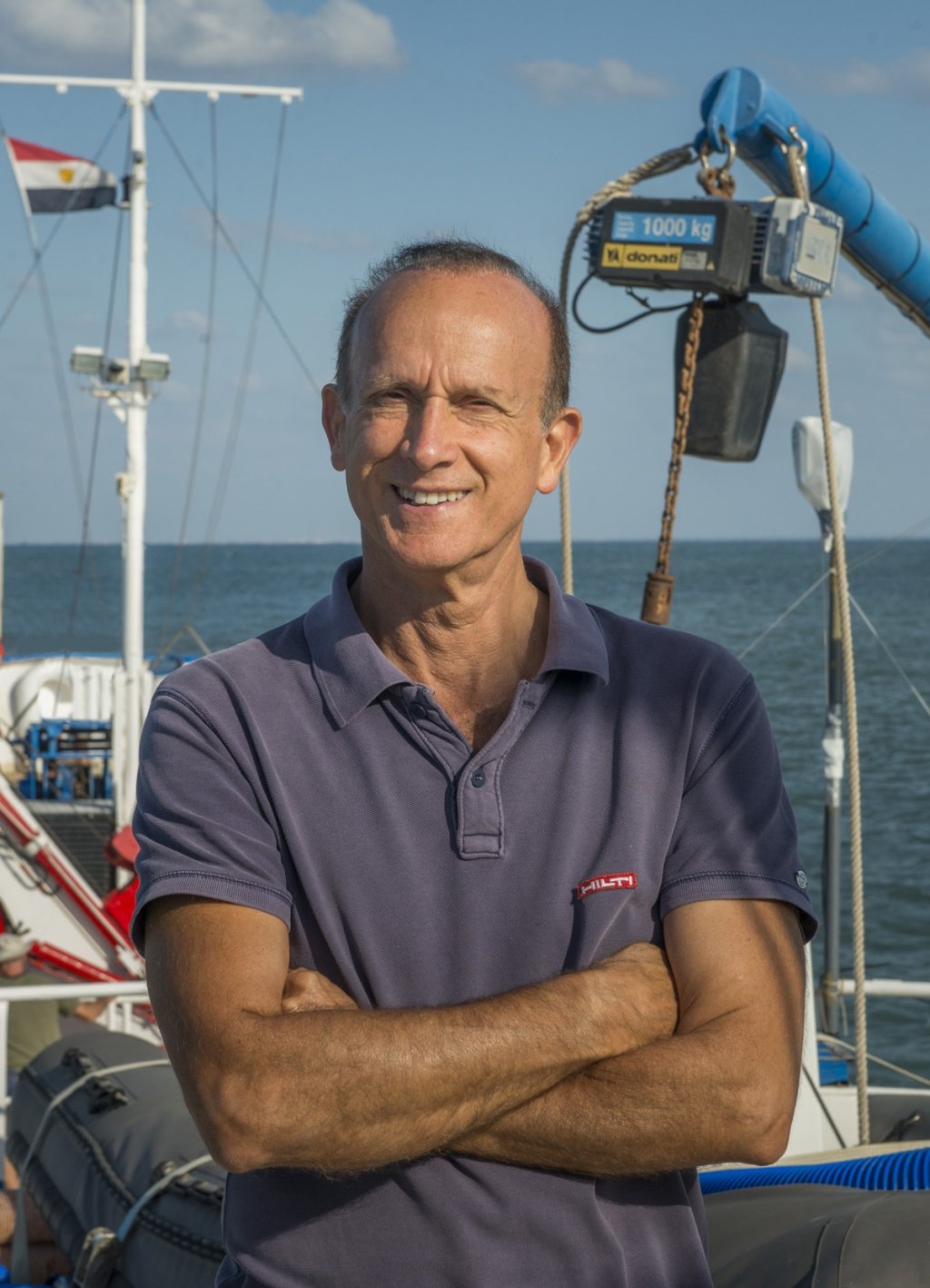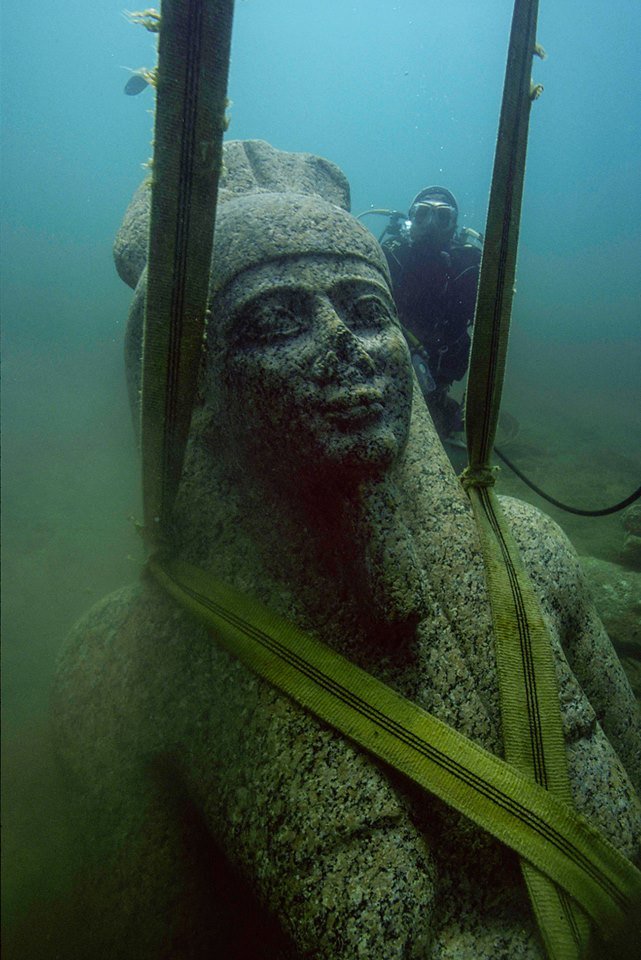Frank Goddio, the deepest living archaeologist (an interview)
Frank Goddio talks about his extraordinary discoveries and the exhibition presenting them at the European audience. And reveals some visionary projects for the future.
We reached Frank Goddio by phone a few weeks before the opening of the Swiss episode of the ground-breaking exhibition that is bringing around the world the fascinating adventure he started in Egypt in 1984, when he laid the foundations for bringing archaeology underwater. The show, titled Osiris and currently hosted by the Museum Rietberg in Zurich after being at the Arab World Institute in Paris and at the British Museum in London (here is a link to our interview with Museum Rietberg’s director, Albert Lutz), is the first one ever made about the mystery of the main Egyptian divinity with pieces excavated from the same site. That are Thonis-Heracleion and Canopus, the enormous sunken cities Goddio discovered in the early nineties under Aboukir bay’s seabed. ‘The pieces here exhibited side by side – points out Mr Goddio – were originally conceived to be side by side. You feel the objects are telling the same story‘. It is the largest archaeological site of the world so far.

Almost 30 years have passed since your project began. How did it start?
Frank Goddio: Most of all I remember several years of studies. Only once we got a sufficiently precise idea of what was there at the time of the Ancient Egypt we started surveying the area using geophysical equipment, but still without touching anything. We needed as much information as we could get and we did a lot of research.
Do you remember the moment when you realised that you would be allowed to run the excavation?
Frank Goddio: In 1984, when I went to Egypt for the first time to discuss about this project, it was clear the technologies available were insufficient for the task. Only in 1991, thanks to an agreement we signed with the French authority for atomic energy, we were provided with atomic resonance magnetometers. The new powerful tools enabled us to see under the seabed. Finally I was able to apply for getting the official permission to excavate the area. At first Egyptian authorities were surprised by the dimension of the project, which was also the very first one of its kind. But they understood it was a good idea and they accepted my request.

Was it like discovering America, or was it like finding the evidence of something that you already knew?
Frank Goddio: Me had signals that something was there, but we were not expecting at all what we would have then discovered. At the beginning we found very big walls surrounding a temple, then we excavated at the centre of the temple and we found a chapel that was inscribed. By comparing this inscription with another inscription engraved on a stele currently preserved in the Cairo museum we understood we were in the temple of Heracleion. Hence in the city of Heracleion. I felt like I was living in a dream. One week after, under the wall of the temple we found an intact stele bearing the name of the city and stating it was the site where the celebration of the mystery of Osiris used to be officiated. We were at the heart of the heart of ancient Egypt religious life. Following up with excavations we found monuments and ritual instruments directly referred to the celebration of Osiris. Anyone entering Egypt had to come through this city and all the trading ships, importing or exporting goods, had to pay taxes and duties part of which had to be allocated to this temple, protecting the Lower Egypt. ‘I order – Pharaoh is speaking – this stele has to be erected in the city of Thonis’. That was beautiful.
What has been the cost of the project up to now?
Frank Goddio: It’s difficult to estimate it. Every year we set a program, and it has to be approved by the board of the institution supporting us, which is the Hilti Foundation. Our partnership started in 1996, and brought to the discovery of Portus Magnus, Thonis Eracleion and Canopus, to their excavation, and to many scientific publications. Not to mention the current exhibition at the Rietberg Museum in Zurich. It is the first exhibition ever made on the most secret ceremony of the Ancient Egypt. (Here is the link to our interview with Micheal Hilti, art collector and member of the directory board of the Hilti Foundation).
What’s your opinion about the local authorities?
Frank Goddio: We have been working together since the beginning. During our last mission, in November 2016, we had eight Egyptian archaeologists on board, and some of them have been working with us since 1992. We know each other and together we are training the new generation of archaeologists that will work on this extraordinary site. I would describe it as a close cooperation with high mutual esteem.
Would you call it a model for cultural cooperation between countries?
Frank Goddio: I must say that we are not representing any country, but to a certain extent I would. We are an international team including people from Germany, France, Spain, Greece, Czech, USA, Russia, Philippines, and Egypt, of course.
What will be the next step?
Frank Goddio: The city of Thonis is twice as big as Pompei, and this latter is under excavation since the 18th century. It follows that in the Aboukir Bay there is still a lot of work that has to be done. I estimate that for each of the three sites – Portus Magnus, Thonis Eracleion and Canopus – it may take centuries to fully understand them. It’s a never ending process. For example, in the case of Thonis, which was very much like Venice with canals and islands around it, we recently found out that under the city there is an older city still to be discovered, probably from the 8th century before Christ.
Why did you choose to excavate the pieces and relocate them in a museum instead of keeping them in their original location? Would it be possible to make the site accessible underwater?
Frank Goddio: We discussed this point a lot with Egypt’s Minister of Antiquity in order to adopt the best policy. We decide on a case-by-case basis, depending on the context. For instance, the Portus Magnus area is naturally protected, and here the idea is to build an underwater museum in order for people to visit the city exactly as it was, and without diving. There will be a central basin leading to tunnels where visitor will walk in. Objects will be left in situ. Or, more precisely, they will be excavated, cleaned, studied, and then placed again in their original location in the hope that at some point this museum will become possible – and Unesco is for it. Unfortunately the case of the Aboukir Bay is different. Thonis Eracleion is 7 kilometres far from the coast and is fully exposed to the sea. Here an underwater museum would not be possible at all.
Are you a collector?
Frank Goddio: Yes, I am. But I don’t collect art. I am fond of souvenirs and books.
February 3, 2021
